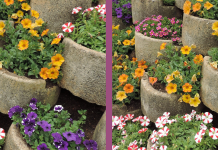If you are an adventurous gardener who likes to grow something out of the ordinary, these gourmet winter greens should be right up your street.
The term gourmet is generally used for dishes, or ingredients, that are more sophisticated or unusual than the run-of-the mill daily fare.
It can certainly be applied to a range of autumn and winter heirloom vegetables from RAW seed, that are not found on normal seed racks.
There are lime green and purple headed cauliflowers, and nutty flavoured quick sprouting broccoli. The heavily veined Savoy cabbage may look intimidating but its flavour is sweet and earthy. There are also winter salad greens with a bite, like the red-leaved radicchio and endive chicory, both staples of the Italian table.

The RAW seed range consists of heirloom and non-GMO varieties that have a long pedigree or originate from regions celebrated for their cuisine. They have been selected for container gardens or small-space growing.
Even the seed packets are different. There is basic info of where to plant and how deep, as well as some not-so-serious facts, and a bit of tongue-in-cheek humour.
Cauliflower Romanesco is a 500 year old brassica from Italy’s Lazio region. It is a cross between a cauliflower and broccoli and has a sweet and nutty flavour. Its lime-green colouring provides additional phytochemicals that stimulate the immune system and protect the body’s cells from damage.

Sow in seed trays and plant out seedlings when they are 10-25cm high, spaced 45cm apart. Plant in full sun, in fertile soil and keep the soil consistently moist. Heads should be ready to harvest 75-100 days after transplanting.
To eat: cut out the central stalk so that the curds fall away. They can be served raw, steamed or boiled in salted water for five minutes. Flavour with salt and pepper, butter, shavings of parmesan cheese, a squeeze of lemon or roasted garlic cloves.
Broccoli Raap ‘Spring Rapini’ is another Italian heirloom veggie also known as Friarielli in Naples. It has pungently flavoured leaves in addition to the sprouts. It has a stronger, nuttier flavour than broccoli with a slightly bitter aftertaste.

Sow directly into the ground, spacing plants 20cm apart. It can be grown in autumn or spring crop and can be harvested within 50-60 days. Sow smaller quantities more often and pick early before the leaves get bitter.
To eat: Cook as greens, either steam, grilled or sauteed with a dash of olive oil and garlic.
Cabbage Savoy is believed to have originated in Europe in the 1500s in a region ruled by the Italian house of Savoy, bordering Italy, Switzerland and France. It is a large, very cold-hardy cabbage.

Like all cabbage it needs fertile soil, and full sun in winter. Space plants 30cm apart because they grow large,1 – 2kg in weight. Harvest within 80-100 days.
To eat: Add the firm, crunchy outer leaves to soups, stews and curries, or braise. The tender inner leaves are good for salads, especially coleslaw. The leaves can also be used as wraps or shredded for stir-fries.
Radicchio ‘Red Treviso’ is grown primarily around the cities of Treviso, Padua and Venice. it is generally believed a Belgium horticulturalist introduced it by applying his country’s horticultural techniques to Italian chicory. It has tender, slightly bitter red leaves with a white mid-rib, and forms a slender, cabbage like head.
 Plant in a well-composted, sunny bed and space 20cm apart. Keep plants well watered because drying out increases the bitterness. Young leaves are less bitter and can be harvested individually. Harvest heads when they feel firm, about 65-75 days from sowing.
Plant in a well-composted, sunny bed and space 20cm apart. Keep plants well watered because drying out increases the bitterness. Young leaves are less bitter and can be harvested individually. Harvest heads when they feel firm, about 65-75 days from sowing.
To eat: Serve raw in salads, grill, sauté or steam. When cooked, the flavour is more mellow and less bitter.
Endive Chicory ‘Catalogna Bi-colour blend’ is a salad leaf with an edge. The curly leaves and crispy white stems add crunch and a tinge of bitterness to winter salads. Pick young, before the plant blooms.

Sow seed directly into the soil or into seed trays. Plant in fertile soil that drains well and space plants 20cm apart. Keep the soil moist and feed and feed every three weeks with a kelp based feed, or compost tea of Margaret Roberts Organic Supercharger. Don’t let the soil dry out as the leaves will become too bitter.
To eat: Serve as a salad vegetable.
TEXT: Alice Coetzee






